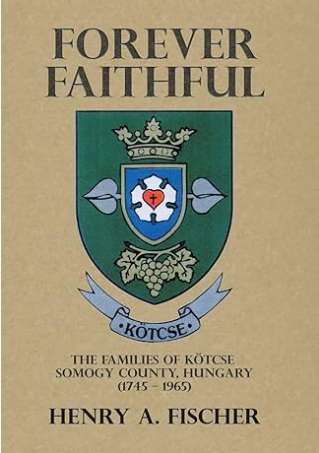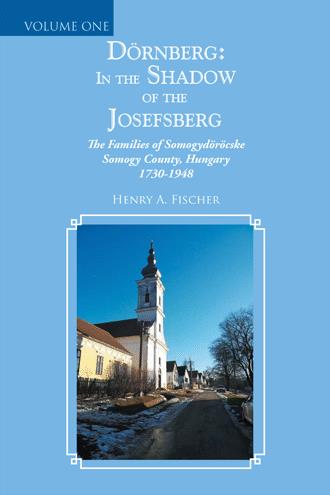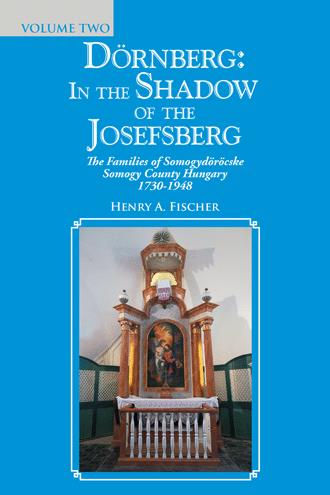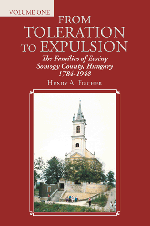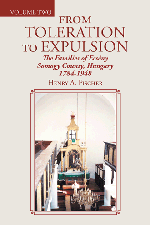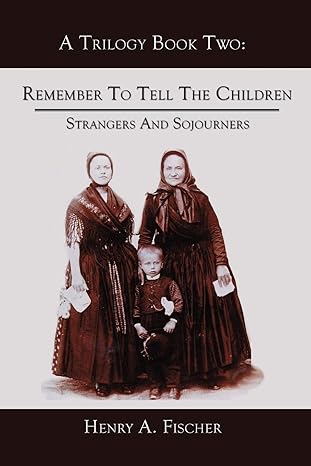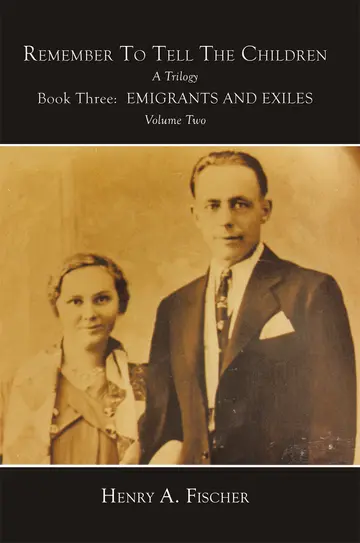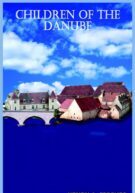Forever Faithful: The Families of Kötcse Somogy County, Hungary (1745 – 1965)
by Henry A Fischer (Author)
Forever Faithful
This is the third in a series of genealogical studies of German families that emigrated to the Kingdom of Hungary in the early 18th century and settled in Somogy County. Kötcse is the oldest of the three major German Lutheran parishes that evolved and numerous families from Kötcse were instrumental in the establishment of the other two. The family histories of those who settled in the parish of Somogydöröcske are included in the volume: Dörnberg: In the Shadow of the Josefsberg; and those from the parish of Ecsény in From Toleration to Expulsion that both preceded this publication. In addition to the genealogical information the author provides the historical context and other information vital to an understanding of the lifestyle, traditions and ultimate destiny of their sojourn in Hungary and beyond.
It is available at Barnes & Noble, Amazon, authorHOUSE, Indigo Chapters, and through other Internet Listings.
ICHTHUS: Sign of the Fish
by Henry A. Fischer (Author)
ICHTHUS: Sign of the Fish
The title itself is the Greek word for fish. The sequence of the Greek letters of the word forms an acrostic for Jesus Christ Son of God Saviour used by the early Christians as a secret symbol to identify themselves to one another. The focus of this historical religious novel is the letter the Apostle Paul wrote to a slave owner named Philemon on behalf his runaway slave Onesimus. Probably one of the least read and underappreciated portions of the New Testament. It is Onesimus’ story which becomes the vehicle to explore and discover the dynamics of the life, expansion and early history of the Christian faith and its development, using the best of biblical scholarship as well as historical research. From his capture as a youngster by the Romans along the Rhine frontier following the defeat of the Chatti tribe and his subsequent separation from his mother who is sent to Rome, he is taken to the East to be sold into slavery in Ephesus in the province of Asia. But in his leave taking from his mother she gives him her amber amulet that bears the crude outline of a fish, the symbol of their clan to remember her and in turn he vows that someday he will find her. In the years that follow he grows up and serves in the household of Philemon, a wealthy estate owner in Laodecia and establishes a quixotic relationship with his young master Archippus that has a long lasting effect on his life that becomes ruptured and eventually leads Onesimus to risk to run away in search of his mother in Rome. That search becomes central for what follows and his eventual encounter with the Apostle Paul. His search for his mother is also a search for his own identity and the meaning of his life in the midst of a society in which he is an outsider, fugitive and very much alone. Unknown to him he is on a spiritual quest despite being devoid of any need or attraction to the religiosity of his time.
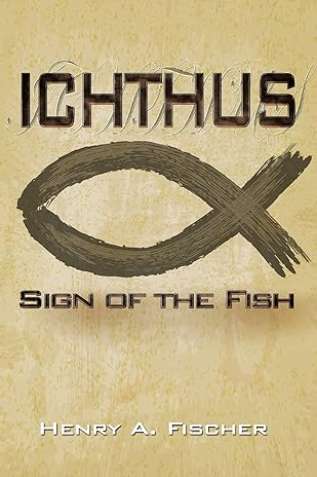
All of this becomes a preparation for the “good news” of the crucified risen Christ and a coming Kingdom that meets the needs and longings of his search. It turns out to be a double search in which he not only finds his mother but also enters upon a new life that will lead to his return to his former master, leaving Rachel the love of his life behind. What follows is set up against the background of the great fire of Rome and the persecution unleashed by the Emperor Nero as recorded by the Roman historian Tacitus. The final phase of Onesimus’ life and his preservation of the writings of the Apostle Paul ends with his martyrdom recorded by the Christian historian Eusebius and the rather miraculous preservation of the Letter to Philemon, “the Gospel in a nutshell.”
It is available at Barnes & Noble, Amazon, authorHOUSE, Indigo Chapters, and through other Internet Listings.
Dörnberg: In the Shadow of the Josefsberg
by Henry A Fischer (Author)
The Families of Somogydöröcske Somogy County, Hungary 1730-1948
In the past, the steep, majestic, heavily forested, and somewhat impregnable Josefsberg was the lair of robber bands and brigands following the expulsion of the Turks from the area and all of Hungary. In future it would become known as the Jószefhegy. It is one of the highest elevations in northeastern Somogy County. In its lengthening shadow, the village of Dörnberg would emerge in the early decades of the eighteenth century named as such by its German settlers in reference to the abundance of thorns in its lower regions. These first settlers were in large part of Hessian origin, having joined the Schwabenzug (the Great Swabian migration) of the eighteenth century into Hungary at the invitation of the Habsburg emperor Charles VI. The fact that they were Lutherans would lead to decades in which they were forced to exist as an underground congregation until the Edict of Toleration was promulgated by the emperor Joseph II in 1782, which led to the naming of the local heights as the Josefsberg in his honor. It was sometime later that the county administration renamed the village, and it became Somogydöröcske. The village would maintain its German character throughout its history until the end of the Second World War when Protocol XIII of the Potsdam Declaration was carried out on April 6, 1948, and the vast majority of the village population was expelled along with the German families in its affiliates in Bonnya and Gadács and sent by cattle car to the then Russian zone of occupation of Germany. Those from Szil followed a week later. This publication is addressed to the English-speaking descendants of those families that immigrated to Canada, Australia, and the United States prior to the Second World War, as well as the families who were successful in escaping from the Russian zone of Germany to the West and were able to find a new home in English-speaking countries. It provides them with genealogical information about their forebears and additional information regarding their life and history.
It is available at Barnes & Noble, Amazon, authorHOUSE, Indigo Chapters, and through other Internet Listings.
From Toleration to Expulsion
by Henry A. Fischer (Author)
After several years of research and writing “From Toleration to Expulsion” has just been published. It is a two volume set by Henry A. Fischer that provides all of the genealogical information that exists with regard to the families that lived in Ecseny, Somogy County in Hungary and its affiliated congregations in Hacs, Polany, Vamos, Somodor, Raksi and Toponar covering most of the period from 1784-1948.
It also contains information on the families that were expelled in 1948, those taken to forced labour in the Soviet Union, those who died in the First and Second World War, the families that migrated to Slavonia, the United States, Canada and Australia and biographical information and stories about individuals and families that played a special part in the life of the village.
There is an introductory portion of the book devoted to the history and life of the village and resources to further family searches. The book is being published on the 260th anniversary of the founding of the village. The set of books are available through amazon.com and authorhouse.com (the publisher). They are also available directly from the author.
It is available at Barnes & Noble, Amazon, authorHOUSE, Indigo Chapters, and through other Internet Listings.
Remember to Tell the Children
by Henry A. Fischer (Author)
Henry A. Fischer’s Remember to Tell the Children trilogy is a sweeping historical saga that traces the journey of the Danube Swabians—German-speaking settlers who migrated to southeastern Europe during the 18th century. Through three volumes, Fischer captures the resilience, faith, and cultural identity of these communities as they navigate centuries of upheaval, displacement, and transformation.
Book One: The Pioneers
This volume introduces the original settlers who left war-torn regions of Germany to colonize the Hungarian frontier under Habsburg rule. Facing harsh conditions, disease, and isolation, they forged new lives through hard work and deep religious conviction. Fischer paints vivid portraits of their struggles and triumphs, emphasizing the importance of oral tradition and storytelling in preserving their legacy.
Book Two: Strangers and Sojourners
As the Danube Swabians become more established, they remain culturally distinct—often viewed as outsiders by their Hungarian neighbors. This book explores the tension between assimilation and preservation, especially during the Napoleonic Wars and the 1848 Hungarian Revolution. The community’s commitment to language, faith, and tradition remains steadfast, even as political and social pressures mount.
Book Three: Emigrants and Exiles
The final volume follows the descendants of the original pioneers into the 20th century, as many face forced migration, persecution, and exile—particularly during and after World War II. Fischer chronicles their journeys to North America and elsewhere, highlighting how memory and storytelling become vital tools for survival and identity.
Across all three books, Fischer’s central message is clear: the stories of these people must be remembered and passed down. The trilogy is both a tribute and a call to action—urging descendants to honor their heritage and ensure that the voices of the past are never silenced.
It is available at Barnes & Noble, Amazon, authorHOUSE, Indigo Chapters, and through other Internet Listings.
Children of the Danube
by Henry A. Fischer (Author)
Children of the Danube by Henry A. Fischer is a compelling historical narrative that traces the journey of the Danube Swabians—ethnic Germans who migrated to southeastern Europe in the 18th century. Fischer blends meticulous research with personal family history to illuminate the lives of these settlers, who traveled down the Danube River to colonize lands devastated by centuries of Ottoman rule.
The book begins with the backdrop of post-Ottoman Hungary, where the Habsburg monarchy invited German-speaking farmers and craftsmen to repopulate and rebuild the region. These migrants, known as Swabians, faced grueling conditions: disease, primitive infrastructure, and cultural isolation. Yet, they persevered, carving out communities rooted in faith, hard work, and tradition.
Fischer’s narrative is not just historical—it’s deeply personal. He recounts the experiences of his own ancestors, weaving their stories into the broader tapestry of migration and survival. Through vivid storytelling, he captures the emotional toll of displacement, the strength of communal bonds, and the enduring spirit of a people determined to thrive in unfamiliar lands.
The book also explores the impact of political and religious forces, including the Counter-Reformation and shifting imperial policies, which shaped the Swabians’ identity and resilience. Fischer’s prose is rich with detail, offering insights into daily life, customs, and the evolving cultural landscape of the Danube basin.
Ultimately, Children of the Danube is a tribute to the endurance of the human spirit. It honors the legacy of a forgotten people whose sacrifices and contributions helped shape Central Europe. Fischer’s work stands as both a historical document and a heartfelt homage, preserving the memory of the Danube Swabians for future generations.
It is available at Barnes & Noble, Amazon, authorHOUSE, Indigo Chapters, and through other Internet Listings.
